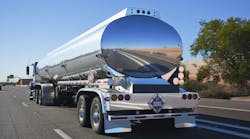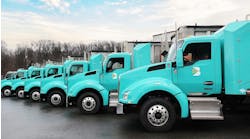In 2010, the Environmental Protection Agency (EPA) issued its Tier 4 standards requiring medium and heavy duty vehicles to reduce engine emissions as part of an ongoing effort to improve air quality. Many manufacturers of these vehicles opted to implement Selective Catalytic Reduction (SCR) technology in their vehicles to remove nitric oxide and nitrogen dioxide (NOx) created by the reaction of nitrogen and oxygen gases in the air during engine combustion.
Diesel exhaust fluid (DEF) is a non-hazardous solution comprised of 32.5 percent urea and 67.5 percent ionized water. It is a critical component of SCR technology, which has been widely accepted as the most effective means to reduce NOx and meet emission requirements set forth by the EPA in its Tier 4 standards.
According to Ron Schornstein, owner of Acustrip, a provider of coolant test strips (www.acustrip.com), consumption of DEF has progressed from zero gallons to 300 million gallons since 2010, and it is expected to reach a billion gallons at some point in the next five years.
“Basically, DEF is here to stay,” he says.
“Some engines were able to meet requirements using EGR, or exhaust gas recirculation,” says Scott Grossbauer, director, Clean Fuel Solutions, Donaldson Company, a provider of filtration systems and replacement parts (www.donaldson.com). EGR is meant to reduce NOx by lowering the oxygen concentration in the combustion chamber and through heat absorption.”
Navistar International had been the only truck OEM to go with EGR, but it transitioned to SCR beginning in 2010.
RETURN ON INVESTMENT
In order for the catalytic conversion process to work properly, fleets need to keep the DEF tanks on their vehicles filled, the same as they would for fuel. That DEF is then injected into a vehicle’s exhaust stream, where it breaks down harmful NOx emissions and turns them into nitrogen and water after combustion.
DEF consumption is roughly 2 percent of fuel consumption, but it can fluctuate based on such factors as load ratings, duty cycle, vehicle operation, among others.
A common concern among fleets is the cost of DEF and the expected return on investment they will see from their purchases. But according to Thomas Kalagher, manager of new product development for Prestone, a provider of antifreeze/coolant (www.prestone.com), as SCR technology has matured, fleets are seeing greater fuel savings than ever before. In addition, the rise of SCR technology has allowed engine manufacturers to develop more fuel-efficient offerings -- without adding to emissions.
“DEF really pays for itself at this point,” he says. “It’s a win-win and an overall cost savings, because you end up with lower exhaust and better fuel economy.”
PURITY AND CONTAMINATION
Smart purchasing decisions are critical to the success of any fleet. The acquisition and use of low-quality DEF can lead to significant consequences, namely additional maintenance and increased costs. If impure or contaminated DEF is used in a vehicle, the catalytic converter in the DEF system can sustain significant damage, leading to increased downtime.
The most prudent way for fleets to ensure they are buying and using pure and uncontaminated DEF is to purchase it exclusively from suppliers that are in compliance with the ISO 22241-1 standard, which specifies the quality characteristics of the NOx reduction agent AUS 32 (aqueous urea solution) needed to operate converters with Selective Catalytic Reduction. Fleets should also buy API-certified DEF. API, (American Petroleum Institute) a national trade association that represents all aspects of America’s oil and natural gas industry, established a voluntary DEF certification program that certifies and monitors certain DEF to ensure it meets ISO performance requirements.
“An API certification means (the supplier) actually sent in samples to API to run a product,” says Prestone’s Kalagher. “They also pull random samples off shelves to test every year to ensure everyone in the marketplace that has API certification is actually meeting those guidelines.”
SHELF LIFE
There is some debate as to the shelf life of DEF and its level of effectiveness as time passes. While DEF’s urea eventually degrades, and the fluid itself decomposes into ammonia gas, DEF can be expected to maintain its effectiveness for more than a year.
“It is really hard to get the DEF to a point where it won’t work well within two years,” says Prestone’s Kalagher.
To maximize its longevity, however, Kalagher suggests fleets should consider:
- Storing DEF at room temperature.
- Preventing DEF from being exposed to direct sunlight.
- Purchasing DEF housed in opaque bottles, rather than clear bottles.
- Keeping DEF from being exposed to temperatures less than 12 degrees F.
- Placing heating rods, insulation blankets and/or heating blankets around DEF tanks on a vehicle to combat cold temperatures.
“When you do have DEF that’s past its expiration, it’s usually fine to use,” he says. “The onboard system on the truck will usually compensate by using a small percentage more instead of rejecting the entire batch.”
RUNNING LOW
It is critical for fleets to heed indicators that their vehicles are running low on DEF to ensure they minimize the risk of downtime, avoid additional repairs and keep their costs in check. Depending on the brand of engine in the vehicle equipped with SCR technology, certain warnings will notify a driver if they need to refill the DEF tank.
“One brand (of engine) gives you a warning you are out of DEF, and you have 50 more miles of operation until the engine is de-rated and you can’t go over 35 mph until DEF is put into the truck,” says Prestone’s Kalagher. “Another brand gives you a certain number of starts. Then, the engine won’t start until DEF is added.”
Whatever the engine brand or warning given, every vehicle’s performance is adversely affected when it runs low on DEF.
“If the system does not have the appropriate DEF, or runs out of DEF, the reduction process cannot take place as designed and emissions of NOx will increase,” says Donaldson’s Grossbauer. “DEF problems can also cause plugging of the SCR catalyst, which will render the vehicle inoperable. If a truck runs out of DEF, the engine is programmed to go into a low-power mode, which could limit (speed) and engine output.”
Drivers should have one to two-and-a-half gallons of packaged DEF readily available in their truck cabs in the event there is no access to a refilling station.
WHEN IT DOUBT, TEST
Every fleet should make a concerted effort to ensure the quality of the DEF being used in its vehicles. According to Acustrip’s Schornstein, if the concentration of the DEF is not 32.5 percent urea - +/- 0.7 percent, the vehicle’s DEF tank should be drained, flushed with distilled water and refilled with new DEF of better quality.
Concentration of DEF should be checked when:
- The vehicle has been stored for an extended period of time.
- There is a chance water has been added to the DEF tank.
- A warning light appears on the vehicle’s dashboard.
“With the DEF, you can also mitigate the risk of contamination if you do simple testing at change points,” he adds. “If you suspect cross-contamination, test for it.”
Possible reasons for contamination can include:
- The DEF tank coolant heating system malfunctioned, allowing coolant to mix with DEF.
- The DEF tank cap is missing or damaged.
- The DEF tank vent malfunctioned.
- The DEF tank was filled with incorrect fluid.
Schornstein recommends fleets use closed DEF systems on their vehicles to ensure purity and quality and to mitigate the risk of contamination. Closed systems employ a valve coupling system to seal the container opening on drums and totes and prevent contaminants from entering the container.
“It’s difficult to have closed systems,” he continues. “If you get something else into DEF, a small bit will contaminate quite a bit.”
That is why, he says, proper and regular testing of DEF is such an important practice for fleets.
“Make sure it is what you think it is,” Schornstein adds.




